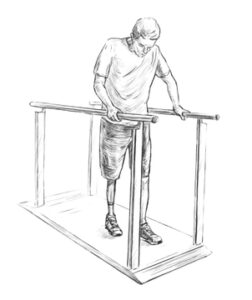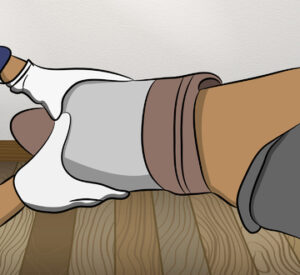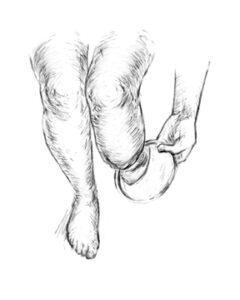If you are reading this right now, you are probably very excited to take the next step in your rehabilitation. (Quite literally speaking! And we can not blame you one bit!!)

Amputee Learning To Walk With New Prosthesis
Although we are cheering for you, we will be saying some precautionary things moving forward so that you are aware of the road ahead.
Although your mind might be telling you that you are ready to go, you need to make sure you pass certain “check points”, so you do not cause yourself more harm than good as you rehabilitate after surgery.
Certain potential complications need to be accounted for ahead of time, such as infection, accidents can happen to the residual limb and fluctuation in edema can effect your ability to walk after your recent surgical procedure.

The use of a shrinker, applied with a donning tube can help control swelling (edema).
1.) Edema Control
Once the edema that you have had immediately after the surgery is under control then the next step is to make sure it has consistently stayed down for some time.
This is important because you want your prosthesis to fit consistently (instead of fitting good one day and bad the next because your swelling is still fluctuating.
2.) Weight Bearing Through Your Residual Limb
When will my physician give me “the go ahead” when it comes time to weight bearing through your residual limb?
That’s a great question. You may feel fine. No pain or notable issues from the surface level. You may feel ready to go but it is best to get the green light from your physician on weight bearing through the healed or healing incision line that you have. One thing you and your clinical team can do, or perhaps are already doing is monitoring the suture line each and every day.

This can be done by using a mirror as shown in the image above. This process can tell you a lot about what is going on at the suture line.
3.) Infections
Infections do happen. Anyone can get them unfortunately, so keeping an eye on the incision line and the healing of your residual limb after surgery is crucial. Infections can delay healing by weeks and monitoring your incision line for excessive redness and draining will be a good idea. Staying proactive is a good idea.
4.) Avoiding Incision Line Ruptures (Wound Dehiscence)
The term that the medical field uses for this is “wound dehiscence” or “dehiscence”. This can basically be a surgical complication that occurs along the surgical incision line that may cause it to open. You might hear other people refer to this incision line opening as a “rupture”. Although it definitely does not happen to everyone, it is something to look out for during your healing process.
Risk factors for wound dehiscence would include diabetes, obesity, accidents to the residual limb through impact (such a fall or collision).
The last thing you want is to rush the healing of that residual limb and then things turn for the worst and the incision line opens. You may have thought of all of this already, but in case you did not, I would suggest you speak with your physician (perhaps your surgeon, if they are available) or perhaps with the in house doctor at your facility to answer this question.
Your prosthetist is not the person who gets to choose when it comes time for you to begin weight bearing. If asked, they are an important voice on the team, but typically this answer comes from your surgeon or other physician you are seeing in rehab.
5.) Weight Bearing Through Your Future Prosthesis
You will need to bear weight through your residual limb in order to stand in your prosthesis. The prosthetic socket will hold onto your residual limb in ways that are meant to be comfortable and to help avoid excessive pressure on the bottom of your residual limb (which is a positive thing). For example, for below knee amputees pressure can be used at the patellar tendon (just below your knee cap) and muscle bellies to help keep you off of the incision that is potentially still healing.
This might seem very obvious after we make the statement, but you recently had a major surgery and there is an incision line that is possibly very sensitive at the very least and if you bare weight though the residual limb too quickly you could stress the incision line past its ability to stay closed. In this case, caution is way better than rushing the process obviously. Then it is quite obvious that you have taken a figurative step backwards, not forwards.
6.) After your Doctor Gives You The Go Ahead
So, now what?
Now the prosthetic treatment of things will start to ramp up.
The prosthetist will take an impression of you for the new check socket you will need. This can be done over a gel liner or not. Within about a week they should return (barring any other complications from insurance) with a temporary leg for you to work with. They do this because they want you to trial the leg before they give you a finished product. Which makes sense, because in the end you will have to be happy with the prosthesis.
